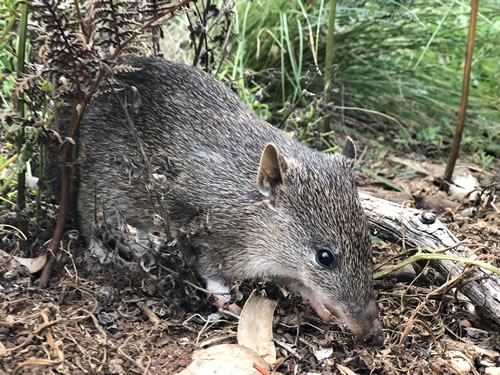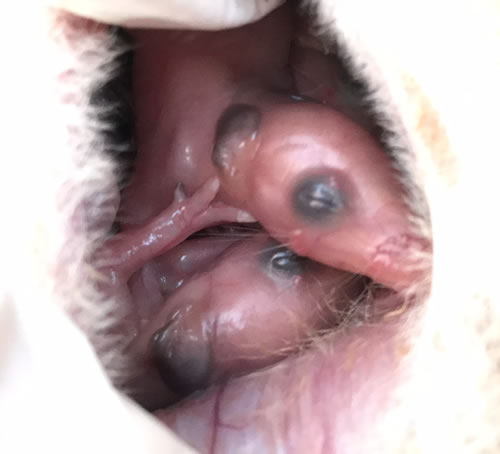28 Nov SOUTHERN BROWN BANDICOOT
Scientific name: Isoodon obesulus
IUCN Conservation Status: Least Concern
 Often confused with rodents, bandicoots are small, omnivorous marsupials. They are about the size of a rabbit and have a pointy snout, humped back, thin tail and large hind feet. The largest of the bandicoots, the Southern brown bandicoot was once widespread along the coast of Northern New South Wales, Queensland, Northern Territory and the tip of Western Australia. However, like many other Australian marsupials, bandicoots have undergone several species extinctions since European settlement because of land clearing and the introduction of feral predators, including foxes, dogs and cats. Of the estimated 12 bandicoot species once present prior to colonisation on the continent, approximately half are now either extinct or threatened.
Often confused with rodents, bandicoots are small, omnivorous marsupials. They are about the size of a rabbit and have a pointy snout, humped back, thin tail and large hind feet. The largest of the bandicoots, the Southern brown bandicoot was once widespread along the coast of Northern New South Wales, Queensland, Northern Territory and the tip of Western Australia. However, like many other Australian marsupials, bandicoots have undergone several species extinctions since European settlement because of land clearing and the introduction of feral predators, including foxes, dogs and cats. Of the estimated 12 bandicoot species once present prior to colonisation on the continent, approximately half are now either extinct or threatened.
The Southern brown bandicoot is an ecological engineer. It helps aerate soil and leaf litter assisting in natural litter breakdown, penetration of seedlings, organic mixing and thus improving nutrient availability for plants. These animals also help spread fungi through the ecosystem, which assist plants to increase nutrient absorption.
Description
The Southern brown bandicoot is a medium-sized, ground-dwelling omnivore marsupial. It is often confused with the Long-nosed bandicoot (Perameles nasuta) or Long-nosed potoroo (Potorous tridactylus), both of which may occur in similar habitats. The Northern brown bandicoot (Isoodon macrourus) is also very similar in appearance to the Southern brown bandicoot.
Adult Southern brown bandicoots have a body length of about 30cms, a short, thin tail with a pointed end, and weigh between 400-1600 grams. The species has a relatively short nose and ears, dark grey or yellowish-brown fur on its upper body, tail and feet and a creamy white belly. Its forelegs are short with curved claws on the digits and the hind limbs are much longer resembling those of macropods (kangaroos, wallabies, etc). The hind feet are characterised by the presence of syndactylus toes, formed by the fusion of the second and third digits, and they primarily are used for grooming.
Habitat
Southern brown bandicoots live in a wide variety of habitats, including rainforests to woodlands and heath. During the day, they nest in shallow holes in the ground, lined with leaf litter and built under dense vegetation or debris, hiding them from predators and protecting them from rain and sun.
Distribution
The Southern brown bandicoot appears south of the Hawkesbury River and the Northern species to the North.
Diet and Behaviour
The Southern brown bandicoot is an omnivore and consumes a wide range of invertebrates, various plant material such as leaves, fruits and seeds and fungi. They mainly forage at night, consuming insects, earthworms, insect larvae and spiders. They also feed on plant tubers, roots and truffle-like fungi to supplement their diet. Bandicoot foraging performs an important role in keeping bushland ecosystems healthy. In their search for food, they often create distinctive conical holes in the soil.
Bandicoots generally live for 2-4 years in the wild; they are territorial and usually solitary. The female stays in a relatively small area to forage and mate, but males have a bigger territory and mark and defend their territory by fighting off other males. They do this by standing on their back legs and clawing at each other’s shoulders and backs, often leaving scars.
Reproduction
Bandicoots are multi-oestrus, meaning they breed several times during the year. Females can give birth to as many as five babies at a time, but usually only one or two survive
Their gestation period is very short, the shortest of any marsupial which is about 11 days. The young are born very tiny and under-developed and are in the mother’s pouch for approximately 2 months. They travel through a cord attached to their mother’s womb to reach the pouch. Here they drink milk from the mother’s teats and grow until they are large enough to leave the pouch. They can begin to live independently at about three months old. Bandicoot pouches are open at the back, to stop dirt entering the pouch when the mother digs.
Threats
Bandicoots, like many of the small to medium-sized marsupials of Australia, have undergone several species extinctions and significant contractions in distribution since European settlement. Of the estimated 12 species of bandicoot in Australia, approximately half are now extinct, threatened with extinction or extremely rare. Reasons for their population decline include:
- Loss and habitat fragmentation for agriculture and urban developments.
- Burning regimes that impact on understorey species and floristic structures.
- Predation by introduced predators such as cats, dogs and foxes.
- Death or injury by fire and motor vehicles.
How Aussie Ark is helping
Aussie Ark has a vision of providing a long-term future to our threatened wildlife. We have already established a growing insurance population at the Ark for the Southern brown bandicoot and expect to have 150 individuals by 2021. We will release the species into safe wild sanctuaries to ensure their future is protected for generations to come. You can help support this species’ future by donating today.



